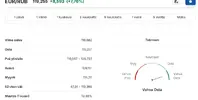Install the app
How to install the app on iOS
Follow along with the video below to see how to install our site as a web app on your home screen.
Note: This feature may not be available in some browsers.
You are using an out of date browser. It may not display this or other websites correctly.
You should upgrade or use an alternative browser.
You should upgrade or use an alternative browser.
Lännen taloussota Venäjälle ja sen seuraukset
- Viestiketjun aloittaja Heinrich
- Aloitus PVM
Harvapartio
Eversti
114.5. romahtaisi nyt vaan koko paska niin säästyisi paljon kärsimystä ja verta. Mutta realistista taitaa olla että keksivät jonkun hätälaastarin jonka voimin kituuttelevat vielä ensi vuoteen pitkälle..112,50. Pariin viikkoon - 15 %. Toivottavasti ovat ostaneet jouluruuat hyvissä ajoin.
Suunnitelman mukaan. Keväällä voi sitten jo lämmittää taloaan ruplan seteleillä.
Antares
Respected Leader
Halusin vilkaista, mitä venäläiset "talousihmiset" ovat kirjoittaneet tästä ruplan kehityksestä.
Sattumalta yhtä Yahoo-nettisivun uutista lukiessa tuli vastaan Yevgeny Kogan ja hänen telegram-kanavansa:
https://t.me/s/bitkogan
Telegram-kanavan kuvauksen käännös:
Investment banker Evgeny Kogan and his team — about the world of investments, economics and the future.
Tämä ei ole minulle entuudestaan tuttu nimi joten suolan kanssa kaikki mitä hän kirjoittaa.
Lainaan spoilerien taakse muutaman tuoreen kirjoituksen liittyen ruplan "kehitykseen".
-
Hän kirjoitti 25.11.2024 näin: LÄHDE
-
26.11.2024 näin: LÄHDE
-
27.11.2024 kahden viestin verran:
-
-
En tosiaan tiedä, miten luotettava kirjoittaja hän on vai onko kyseessä käärmeöljykauppias.
Ensimmäisen viestin sävy on optimistisin (ryssäläisittäin nähtynä):
We can draw analogies with the summer sanctions on imports. Then the ruble strengthened by an average of 4% over two months. In today's reality, this could mean a weakening of the ruble to an average of 104.5 rubles per dollar in December-January.
Partially, the decline in oil and gas exports will be smoothed out by currency sales from the state within the framework of the budget rule. Therefore, I do not expect a catastrophe. As new cross-border payments are built in the new year, we may see the ruble return below 100 rubles per dollar.
-
Hän arvioi että ruplan kehitys johtuisi ennenkaikkea pankkeihin kohdistuneista sanktioista ja niiden seuraamuksista, mutta olettaa kehityksen kääntyvän toiseen suuntaan kunhan "uudet rajan ylittävät maksumenetelmät on rakennettu". Näiden seurauksena rupla tulisi palaamaan alle 100 ruplaa per dollari tasolle.
Tuoreimmassakaan viestissä hän ei ennakoi 130-150 ruplaa per dollari tason saavuttamista tosin kirjoituksen sävy ei ole ehdottoman varma.
Sattumalta yhtä Yahoo-nettisivun uutista lukiessa tuli vastaan Yevgeny Kogan ja hänen telegram-kanavansa:
https://t.me/s/bitkogan
Telegram-kanavan kuvauksen käännös:
Investment banker Evgeny Kogan and his team — about the world of investments, economics and the future.
Tämä ei ole minulle entuudestaan tuttu nimi joten suolan kanssa kaikki mitä hän kirjoittaa.
Lainaan spoilerien taakse muutaman tuoreen kirjoituksen liittyen ruplan "kehitykseen".
-
Hän kirjoitti 25.11.2024 näin: LÄHDE
https://t.me/bitkogan/25575
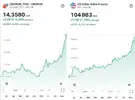
What about the ruble?
The ruble continues to weaken against foreign currencies. The yuan is already trading at 14.3, the dollar at 104.
What next?
The dynamics of the ruble will depend on who suffered more from the new sanctions: exporters or importers? A blow to exports leads to a weakening of the ruble, while a blow to imports leads to a strengthening.
 We don't have reliable data. But my opinion is that the sanctions will hit exports harder, primarily because of Gazprombank. For the same reason, it is difficult to talk about any specific levels.
We don't have reliable data. But my opinion is that the sanctions will hit exports harder, primarily because of Gazprombank. For the same reason, it is difficult to talk about any specific levels.
We can draw analogies with the summer sanctions on imports. Then the ruble strengthened by an average of 4% over two months. In today's reality, this could mean a weakening of the ruble to an average of 104.5 rubles per dollar in December-January.
Partially, the decline in oil and gas exports will be smoothed out by currency sales from the state within the framework of the budget rule. Therefore, I do not expect a catastrophe. As new cross-border payments are built in the new year, we may see the ruble return below 100 rubles per dollar.
 ️At the same time, risks of increased volatility remain. There are no guarantees that exports will not suffer significantly, and the ruble will not continue to weaken. We have been building up a defensive position in the currency in advance. The most attractive instruments now are yuan liquidity funds. Last week, even before the sanctions, we discussed them in detail at a seminar. Hedging currency risks remains relevant today.
️At the same time, risks of increased volatility remain. There are no guarantees that exports will not suffer significantly, and the ruble will not continue to weaken. We have been building up a defensive position in the currency in advance. The most attractive instruments now are yuan liquidity funds. Last week, even before the sanctions, we discussed them in detail at a seminar. Hedging currency risks remains relevant today.
#ruble
 this bit
this bit
t.me/bitkogan/25575
46.0Kviews
November 25 at 18:35

What about the ruble?
The ruble continues to weaken against foreign currencies. The yuan is already trading at 14.3, the dollar at 104.
What next?
The dynamics of the ruble will depend on who suffered more from the new sanctions: exporters or importers? A blow to exports leads to a weakening of the ruble, while a blow to imports leads to a strengthening.
 We don't have reliable data. But my opinion is that the sanctions will hit exports harder, primarily because of Gazprombank. For the same reason, it is difficult to talk about any specific levels.
We don't have reliable data. But my opinion is that the sanctions will hit exports harder, primarily because of Gazprombank. For the same reason, it is difficult to talk about any specific levels.We can draw analogies with the summer sanctions on imports. Then the ruble strengthened by an average of 4% over two months. In today's reality, this could mean a weakening of the ruble to an average of 104.5 rubles per dollar in December-January.
Partially, the decline in oil and gas exports will be smoothed out by currency sales from the state within the framework of the budget rule. Therefore, I do not expect a catastrophe. As new cross-border payments are built in the new year, we may see the ruble return below 100 rubles per dollar.
 ️At the same time, risks of increased volatility remain. There are no guarantees that exports will not suffer significantly, and the ruble will not continue to weaken. We have been building up a defensive position in the currency in advance. The most attractive instruments now are yuan liquidity funds. Last week, even before the sanctions, we discussed them in detail at a seminar. Hedging currency risks remains relevant today.
️At the same time, risks of increased volatility remain. There are no guarantees that exports will not suffer significantly, and the ruble will not continue to weaken. We have been building up a defensive position in the currency in advance. The most attractive instruments now are yuan liquidity funds. Last week, even before the sanctions, we discussed them in detail at a seminar. Hedging currency risks remains relevant today.#ruble
 this bit
this bitt.me/bitkogan/25575
46.0Kviews
November 25 at 18:35
-
26.11.2024 näin: LÄHDE
https://t.me/bitkogan/25580
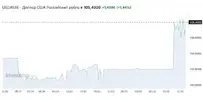
The dollar is already above 105 rubles, the euro is above 110. What to expect?
So far, I don’t see any reason for a strong slump in the ruble. A fall of a few more percent is quite possible. But I don’t believe those who predict 120-150 rubles per dollar.
And let’s not forget one more thing – inflation. On average, a 10% change in the exchange rate contributes about 0.5 percentage points to inflation over a period of about a quarter. So an additional 0.4 percentage points plus to inflation has already accumulated… For the Bank of Russia, this is a difficulty in combating rising prices.
 Right now, things are going well for those who are sitting in replacement bonds or yuan liquidity funds. People are getting their returns on top of the currency.
Right now, things are going well for those who are sitting in replacement bonds or yuan liquidity funds. People are getting their returns on top of the currency.
#currency
 bitcogan
bitcogan
t.me/bitkogan/25580
41.7Kviews
Nov 26 at 12:32

The dollar is already above 105 rubles, the euro is above 110. What to expect?
So far, I don’t see any reason for a strong slump in the ruble. A fall of a few more percent is quite possible. But I don’t believe those who predict 120-150 rubles per dollar.
And let’s not forget one more thing – inflation. On average, a 10% change in the exchange rate contributes about 0.5 percentage points to inflation over a period of about a quarter. So an additional 0.4 percentage points plus to inflation has already accumulated… For the Bank of Russia, this is a difficulty in combating rising prices.
 Right now, things are going well for those who are sitting in replacement bonds or yuan liquidity funds. People are getting their returns on top of the currency.
Right now, things are going well for those who are sitting in replacement bonds or yuan liquidity funds. People are getting their returns on top of the currency.#currency
 bitcogan
bitcogant.me/bitkogan/25580
41.7Kviews
Nov 26 at 12:32
-
27.11.2024 kahden viestin verran:
https://t.me/bitkogan/25585
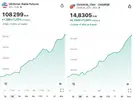
Is the ruble being deliberately devalued?
Yesterday, many paid attention to the Finance Minister's statement that the current ruble exchange rate helps exports, and asked the question: "Maybe the ruble is being deliberately devalued?" However, this statement was taken out of context. The minister was not discussing the impact of the exchange rate on the economy as a whole, but how exporters can cope with high interest rates.
So what is happening to the ruble? The currency's fall is not the result of a "cunning plan" by the government, but the market's reaction to geopolitical risks and worsening foreign trade conditions, especially for exporters.
 There is nothing to add to the first one - you have already seen everything in the news: ATACMS strikes on Russian territory are becoming commonplace, as well as new sanctions from the US, EU and G7...
There is nothing to add to the first one - you have already seen everything in the news: ATACMS strikes on Russian territory are becoming commonplace, as well as new sanctions from the US, EU and G7...
 As for the second, according to Bloomberg, Russian oil exports have fallen to their lowest level in two months, mainly due to a sharp reduction in supplies to India.
As for the second, according to Bloomberg, Russian oil exports have fallen to their lowest level in two months, mainly due to a sharp reduction in supplies to India.
China is not helping either. If in the first quarter, Russian oil supplies to China grew by 12.9%, then in the second they fell by 2.6%, and in the third - by 6.8%.
 Further prospects for exports are clouded by sanctions against Gazprombank, through which settlements are made, and the fear of countries about secondary sanctions. This may lead to a significant reduction in foreign exchange earnings until new channels for export settlements are established.
Further prospects for exports are clouded by sanctions against Gazprombank, through which settlements are made, and the fear of countries about secondary sanctions. This may lead to a significant reduction in foreign exchange earnings until new channels for export settlements are established.
Should we expect currency interventions?
The Central Bank reacts not to the ruble exchange rate itself, but to its volatility. For example, the dollar exchange rate of around 105 rubles does not in itself cause concern for the Central Bank. But too fast a rate of depreciation is a reason for intervention. If the ruble continues to depreciate sharply, the Central Bank may suspend currency purchases within the framework of the budget rule. But if the rate stabilizes at the current level, then most likely the regulator will not take additional measures.
Well, the main question is: for how long?
The dollar is already above 108, the yuan is 14.8. And we cannot guarantee that the fall of the ruble will stop even after another percent decline. But it is unlikely that we will see any global downward movements of the ruble and the dollar at 120-150. It may be too late to rush to buy dollars or other currencies. And it is even more unwise to short the ruble.
 The only nuance is that we don’t yet know how hard the 15th package of sanctions from the EU can hit exporters. And if the blow is unexpectedly strong, the ruble’s downward movement may be stronger than our forecasts. But... let’s not draw conclusions yet. Let’s just wait and see, and then we’ll figure it out.
The only nuance is that we don’t yet know how hard the 15th package of sanctions from the EU can hit exporters. And if the blow is unexpectedly strong, the ruble’s downward movement may be stronger than our forecasts. But... let’s not draw conclusions yet. Let’s just wait and see, and then we’ll figure it out.
In the meantime, as we advised at the seminar a week ago, we continue to hold replacement bonds and liquidity funds in yuan. They are growing. And that’s good.
But what should investors do in this case — for example, should they traditionally buy, as we do with any devaluation, shares of exporters? We will discuss this today in a separate note.
#ruble #sanctions
 bitcogan
bitcogan
t.me/bitkogan/25585
32.3Kviews
Nov 27 at 11:51

Is the ruble being deliberately devalued?
Yesterday, many paid attention to the Finance Minister's statement that the current ruble exchange rate helps exports, and asked the question: "Maybe the ruble is being deliberately devalued?" However, this statement was taken out of context. The minister was not discussing the impact of the exchange rate on the economy as a whole, but how exporters can cope with high interest rates.
So what is happening to the ruble? The currency's fall is not the result of a "cunning plan" by the government, but the market's reaction to geopolitical risks and worsening foreign trade conditions, especially for exporters.
 There is nothing to add to the first one - you have already seen everything in the news: ATACMS strikes on Russian territory are becoming commonplace, as well as new sanctions from the US, EU and G7...
There is nothing to add to the first one - you have already seen everything in the news: ATACMS strikes on Russian territory are becoming commonplace, as well as new sanctions from the US, EU and G7... As for the second, according to Bloomberg, Russian oil exports have fallen to their lowest level in two months, mainly due to a sharp reduction in supplies to India.
As for the second, according to Bloomberg, Russian oil exports have fallen to their lowest level in two months, mainly due to a sharp reduction in supplies to India.China is not helping either. If in the first quarter, Russian oil supplies to China grew by 12.9%, then in the second they fell by 2.6%, and in the third - by 6.8%.
 Further prospects for exports are clouded by sanctions against Gazprombank, through which settlements are made, and the fear of countries about secondary sanctions. This may lead to a significant reduction in foreign exchange earnings until new channels for export settlements are established.
Further prospects for exports are clouded by sanctions against Gazprombank, through which settlements are made, and the fear of countries about secondary sanctions. This may lead to a significant reduction in foreign exchange earnings until new channels for export settlements are established.Should we expect currency interventions?
The Central Bank reacts not to the ruble exchange rate itself, but to its volatility. For example, the dollar exchange rate of around 105 rubles does not in itself cause concern for the Central Bank. But too fast a rate of depreciation is a reason for intervention. If the ruble continues to depreciate sharply, the Central Bank may suspend currency purchases within the framework of the budget rule. But if the rate stabilizes at the current level, then most likely the regulator will not take additional measures.
Well, the main question is: for how long?
The dollar is already above 108, the yuan is 14.8. And we cannot guarantee that the fall of the ruble will stop even after another percent decline. But it is unlikely that we will see any global downward movements of the ruble and the dollar at 120-150. It may be too late to rush to buy dollars or other currencies. And it is even more unwise to short the ruble.
 The only nuance is that we don’t yet know how hard the 15th package of sanctions from the EU can hit exporters. And if the blow is unexpectedly strong, the ruble’s downward movement may be stronger than our forecasts. But... let’s not draw conclusions yet. Let’s just wait and see, and then we’ll figure it out.
The only nuance is that we don’t yet know how hard the 15th package of sanctions from the EU can hit exporters. And if the blow is unexpectedly strong, the ruble’s downward movement may be stronger than our forecasts. But... let’s not draw conclusions yet. Let’s just wait and see, and then we’ll figure it out.In the meantime, as we advised at the seminar a week ago, we continue to hold replacement bonds and liquidity funds in yuan. They are growing. And that’s good.
But what should investors do in this case — for example, should they traditionally buy, as we do with any devaluation, shares of exporters? We will discuss this today in a separate note.
#ruble #sanctions
 bitcogan
bitcogant.me/bitkogan/25585
32.3Kviews
Nov 27 at 11:51
-
https://t.me/bitkogan/25587
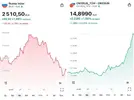
Weakening of the ruble and exporters
The USD / RUB pair has recently exceeded the 111 mark. At the same time, exporter shares are in no hurry to grow. Why is that?
After all, the following usually happens:
 fall of the ruble
fall of the ruble
 immediate (or with a small lag) growth of exporters' shares.
immediate (or with a small lag) growth of exporters' shares.
And now everything looks a little sadder. There are a number of reasons for this.
 Firstly, the correction on the Russian stock market. The Moscow Exchange index has fallen by more than 13% from its November maximum . In such conditions, it is difficult for exporters to grow. Investor sentiment is far from positive.
Firstly, the correction on the Russian stock market. The Moscow Exchange index has fallen by more than 13% from its November maximum . In such conditions, it is difficult for exporters to grow. Investor sentiment is far from positive.
 Secondly, sanctions against Gazprombank and other banks, through which the main settlements for Russian exports were made. As far as we understand, the restrictions introduced will mostly affect Russian exporters, namely those who made settlements through now sanctioned banks.
Secondly, sanctions against Gazprombank and other banks, through which the main settlements for Russian exports were made. As far as we understand, the restrictions introduced will mostly affect Russian exporters, namely those who made settlements through now sanctioned banks.
In such a case, problems with making payments may be observed, which, naturally, can negatively affect the income of exporting companies.
 Thirdly, a certain time lag must pass. Exporters do not grow lightning fast following the currency.
Thirdly, a certain time lag must pass. Exporters do not grow lightning fast following the currency.
That is, we can still see the growth of exporters' shares with a high degree of probability over time. Most likely, this is already the near future. But then... in a week or two, exporters' shares will start to grow... This is already a creative question, as they say.
Which of the exporters wins more in this situation?
There are enough such issuers. PhosAgro, Rosneft, Alrosa, GMK, LUKOIL and others. Separately, it is necessary to note Surgutneftegaz's preferred shares, the forward dividend on which only increases following the weakening of the ruble.
 In the near future, as we usually do at the end of the year, we will publish a forecast for company dividends based on the current realities regarding the exchange rate.
In the near future, as we usually do at the end of the year, we will publish a forecast for company dividends based on the current realities regarding the exchange rate.
Bottom line.
We expect growth in exporter shares, but with a certain lag. Explosive growth? I'm not sure.
I'm afraid the conditions do not allow it yet. Nevertheless, the financial results of exporters in the 4th quarter may pleasantly surprise investors.
In short, let's not panic. We are not sitting and saying that 130 will be soon. Or 150. But we are thinking faster about which of the exporters we will buy. Well, we will definitely buy someone in the application. As they say, watch my hands.
#ruble #shares
 bitcogan
bitcogan
t.me/bitkogan/25587
17.9Kviews
Nov 27 at 14:09

Weakening of the ruble and exporters
The USD / RUB pair has recently exceeded the 111 mark. At the same time, exporter shares are in no hurry to grow. Why is that?
After all, the following usually happens:
 fall of the ruble
fall of the ruble immediate (or with a small lag) growth of exporters' shares.
immediate (or with a small lag) growth of exporters' shares.And now everything looks a little sadder. There are a number of reasons for this.
 Firstly, the correction on the Russian stock market. The Moscow Exchange index has fallen by more than 13% from its November maximum . In such conditions, it is difficult for exporters to grow. Investor sentiment is far from positive.
Firstly, the correction on the Russian stock market. The Moscow Exchange index has fallen by more than 13% from its November maximum . In such conditions, it is difficult for exporters to grow. Investor sentiment is far from positive. Secondly, sanctions against Gazprombank and other banks, through which the main settlements for Russian exports were made. As far as we understand, the restrictions introduced will mostly affect Russian exporters, namely those who made settlements through now sanctioned banks.
Secondly, sanctions against Gazprombank and other banks, through which the main settlements for Russian exports were made. As far as we understand, the restrictions introduced will mostly affect Russian exporters, namely those who made settlements through now sanctioned banks.In such a case, problems with making payments may be observed, which, naturally, can negatively affect the income of exporting companies.
 Thirdly, a certain time lag must pass. Exporters do not grow lightning fast following the currency.
Thirdly, a certain time lag must pass. Exporters do not grow lightning fast following the currency.That is, we can still see the growth of exporters' shares with a high degree of probability over time. Most likely, this is already the near future. But then... in a week or two, exporters' shares will start to grow... This is already a creative question, as they say.
Which of the exporters wins more in this situation?
There are enough such issuers. PhosAgro, Rosneft, Alrosa, GMK, LUKOIL and others. Separately, it is necessary to note Surgutneftegaz's preferred shares, the forward dividend on which only increases following the weakening of the ruble.
 In the near future, as we usually do at the end of the year, we will publish a forecast for company dividends based on the current realities regarding the exchange rate.
In the near future, as we usually do at the end of the year, we will publish a forecast for company dividends based on the current realities regarding the exchange rate.Bottom line.
We expect growth in exporter shares, but with a certain lag. Explosive growth? I'm not sure.
I'm afraid the conditions do not allow it yet. Nevertheless, the financial results of exporters in the 4th quarter may pleasantly surprise investors.
In short, let's not panic. We are not sitting and saying that 130 will be soon. Or 150. But we are thinking faster about which of the exporters we will buy. Well, we will definitely buy someone in the application. As they say, watch my hands.
#ruble #shares
 bitcogan
bitcogant.me/bitkogan/25587
17.9Kviews
Nov 27 at 14:09
-
En tosiaan tiedä, miten luotettava kirjoittaja hän on vai onko kyseessä käärmeöljykauppias.
Ensimmäisen viestin sävy on optimistisin (ryssäläisittäin nähtynä):
We can draw analogies with the summer sanctions on imports. Then the ruble strengthened by an average of 4% over two months. In today's reality, this could mean a weakening of the ruble to an average of 104.5 rubles per dollar in December-January.
Partially, the decline in oil and gas exports will be smoothed out by currency sales from the state within the framework of the budget rule. Therefore, I do not expect a catastrophe. As new cross-border payments are built in the new year, we may see the ruble return below 100 rubles per dollar.
-
Hän arvioi että ruplan kehitys johtuisi ennenkaikkea pankkeihin kohdistuneista sanktioista ja niiden seuraamuksista, mutta olettaa kehityksen kääntyvän toiseen suuntaan kunhan "uudet rajan ylittävät maksumenetelmät on rakennettu". Näiden seurauksena rupla tulisi palaamaan alle 100 ruplaa per dollari tasolle.
Tuoreimmassakaan viestissä hän ei ennakoi 130-150 ruplaa per dollari tason saavuttamista tosin kirjoituksen sävy ei ole ehdottoman varma.
Viimeksi muokattu:
Hanski
Respected Leader
Tukiostoihin ei selvästi ole enää varaa tai tsaari päättänyt päästää ruplan kellumaan (uppoamaan).114.5. romahtaisi nyt vaan koko paska niin säästyisi paljon kärsimystä ja verta. Mutta realistista taitaa olla että keksivät jonkun hätälaastarin jonka voimin kituuttelevat vielä ensi vuoteen pitkälle..
Valtion velan kauppa on myös sujunut heikosti. Runsas 5 miljardia saatu lainoja myytyä, tarvetta olisi melkein 500:lle miljardille, jos aikovat näillä budjettivajeen kattaa.
Hanski
Respected Leader
Voi alkaa puskea Elvira-raukalla vähän stressiä! Ja vain pahempaa on tiedossa...Valtion velan kauppa on myös sujunut heikosti. Runsas 5 miljardia saatu lainoja myytyä, tarvetta olisi melkein 500:lle miljardille, jos aikovat näillä budjettivajeen kattaa.
Näyttääpäs ruplan suunta ihanalta. Oon ollu selittämättömästä syystä tänään todella hyvällä fiiliksellä, mutta ehkä se johtuu tuosta. Ruble is going rubble.
1RUB=114$ taitaa olla viimesin.
1RUB=114$ taitaa olla viimesin.
Tämä vauhti kun pysyy, niin sitähän joutuu viikonloppuna jotain kilistelemään.Näyttääpäs ruplan suunta ihanalta. Oon ollu selittämättömästä syystä tänään todella hyvällä fiiliksellä, mutta ehkä se johtuu tuosta. Ruble is going rubble.
1RUB=114$ taitaa olla viimesin.
ido59
Majuri
Gazpromin arvo dropannut vuodesta 2008 sadasosaan. Osakkeen arvo lienee realistinen kuvaaja ryssän kaasubusineksen tilasta.
StepanRudanskij
Greatest Leader
Noita pitäisi nyt ostaa. Joskus tulevaisuudessa vois saada hyvän katteen.Gazpromin arvo dropannut vuodesta 2008 sadasosaan. Osakkeen arvo lienee realistinen kuvaaja ryssän kaasubusineksen tilasta.
StepanRudanskij
Greatest Leader
Laitan mä muutaman lottorivinkin silloin tällöin...
BallistinenNahjus
Luutnantti
Molemmat korkeariskisiä ja heikkotuotto-odotuksisia sijoitusvaihtoehtoja.Laitan mä muutaman lottorivinkin silloin tällöin...
Mutta toisessa vaihtoehdossa ei tue ryssävaltiota.Molemmat korkeariskisiä ja heikkotuotto-odotuksisia sijoitusvaihtoehtoja.
arix
Respected Leader
Liian aikaista vaikka tuonne pystyisikin sijoittamaan, putoaa vielä...Noita pitäisi nyt ostaa. Joskus tulevaisuudessa vois saada hyvän katteen.
ido59
Majuri
Määräaikaistalletukset vähentyneet Smartin nimeämättömän lähteen mukaan viime kuussa merkittävästi. Jopa lähes 6%. Vaikka korko korkealla. ruplan noidankehä pyörimässä. Hyvä niin. Mihin muuten mahtavat varoja siirtää, kun pörssi sukeltaa, inflaatio jyllää eikä ulkomaillekaan ilmeisesti luvallisin keinoin rahoja saa siirrettyä? 

Siinä sitä onkin olikarkilla miettiminen mihin rahansa, omaosuus ei saa kuitenkaan olla takavarikoitavissakaan puuttinin kassaan. Kulta mahtaa sitten käytännössä olla jo hinnoissaan, jos ruplilla meinaa ostaa?Määräaikaistalletukset vähentyneet Smartin nimeämättömän lähteen mukaan viime kuussa merkittävästi. Jopa lähes 6%. Vaikka korko korkealla. ruplan noidankehä pyörimässä. Hyvä niin. Mihin muuten mahtavat varoja siirtää, kun pörssi sukeltaa, inflaatio jyllää eikä ulkomaillekaan ilmeisesti luvallisin keinoin rahoja saa siirrettyä?
-TripleX-
Respected Leader
Kun ryssillä muuten menee niin hienosti taloudessa niin laitetaampa vaihteeksi vähän mollisävytteisempää uutisointia.
Ursula von der Leyen ajaa ryssien LNG:n käytön lopettamista EU:ssa, tämähän katkaisee toteutuessaan jälleen yhden jalan taloudesta.

Ja jalostamojen marginaalit on niin heikot tai jopa negatiiviset kotimaassa, joten osa jalostamoista on mieluummin kiinni kuin tuottaa polttoaineita etenkin kun vienti on kielletty. Toisaalta vientikin voisi olla haastavaa kun esimerkiksi Kiinaan ja Intiaan on syntynyt kapasiteettia enemmän kuin kulutusta, aivan hiljattain Kiinassa meni kolme jalostamoa konkurssiin, joiden kapasiteetti oli 3 % koko maan polttoaineen tarpeesta, se on melkoinen määrä liikennepolttoaineita liikaa markkinoilla ja tarkoittaa, että ei sinne ryssien bensoja tarvita. Joten en usko, että vientikiellon kumoaminen olisi mikään iso apu ryssäjalostamoille, osa voisi viedä Afrikkaan ja ehkä Etelä-Amerikkaan, mutta se on pientä voluumia sekä kallista rahdata.
 www.hellenicshippingnews.com
www.hellenicshippingnews.com

 www.offshore-technology.com
www.offshore-technology.com
Ursula von der Leyen ajaa ryssien LNG:n käytön lopettamista EU:ssa, tämähän katkaisee toteutuessaan jälleen yhden jalan taloudesta.

Russian LNG imports to EU must end – von der Leyen
Replacing these volumes will be a priority task for the EU energy commissioner candidate, Denmark’s Dan Jorgensen, she told the parliament ahead of a vote to confirm her new team of commissioners for the next five years. “It is high time to make that happen and I know this [parliament]
montelnews.com
Ja jalostamojen marginaalit on niin heikot tai jopa negatiiviset kotimaassa, joten osa jalostamoista on mieluummin kiinni kuin tuottaa polttoaineita etenkin kun vienti on kielletty. Toisaalta vientikin voisi olla haastavaa kun esimerkiksi Kiinaan ja Intiaan on syntynyt kapasiteettia enemmän kuin kulutusta, aivan hiljattain Kiinassa meni kolme jalostamoa konkurssiin, joiden kapasiteetti oli 3 % koko maan polttoaineen tarpeesta, se on melkoinen määrä liikennepolttoaineita liikaa markkinoilla ja tarkoittaa, että ei sinne ryssien bensoja tarvita. Joten en usko, että vientikiellon kumoaminen olisi mikään iso apu ryssäjalostamoille, osa voisi viedä Afrikkaan ja ehkä Etelä-Amerikkaan, mutta se on pientä voluumia sekä kallista rahdata.
Russian refineries runs likely to suffer on poor margins | Hellenic Shipping News Worldwide

Sinochem may retain three bankrupt refineries in China due to low auction interest
Sinochem Group is considering retaining three bankrupt oil refineries in eastern China after auctions to sell them attracted little interest.
 www.offshore-technology.com
www.offshore-technology.com
Jefreitteri
Korpraali
Jos rupla ei ole vapaasti vaihdettava valuutta (keskuspankki määrittää virallisen vaihtokurssin), niin mitä kursseja nuo käyrät esittävät? Ovatko ne kuvaajia suurimpien pankkien välisestä keskikurssista, joka voi siis määräytyä vapaasti kysynnän ja tarjonnan mukaan keskuspankin määräämättä? Siinä tapauksessahan kurssissa on jonkinmoinen arbitraasimahdollisuus. Toisaalta markkinakurssi saattaisi olla hinnoiteltu myös sen vaihtoehdon varalta, ettei Ryssälässä määrätyillä valuuttakursseilla voisikaan pian enää lunastaa dollareita rupliksi ja päinvastoin.



